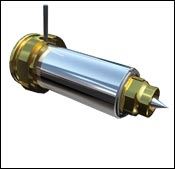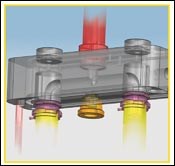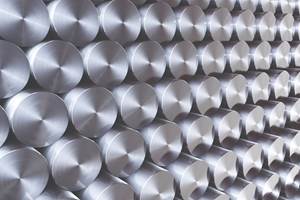How to Evaluate Hot Runner Nozzless
The way to choose the right hot runner nozzle is to evaluate the entire molding system first.
How do you go about evaluating hot runner nozzles? First, evaluate the entire molding system—including part design, plastics material, part weight, cycle time, mold, runner, gates (valve or thermal), nozzles, temperature control and molding machine characteristics. Secondly, move from theory to practical application. To begin ask yourself, “Have I ever done this before?” Then take a look at the benefits and challenges of available hot runner systems. To make it easier and to get you started, the evaluation process has been broken down into 10 considerations including a close examination of hot runner nozzles.
Factors to Consider First
Let’s explore 10 key considerations when evaluating hot runner technology:
1. Part Design
Ideally, the part would have been initially designed with the expectation that it would be produced in a hot runner mold. It will allow good flow of materials, a clean finish at the end of the cycle and easy ejection.
2. Plastics Material
Variables include flow rates (viscosity), susceptibility to burning and processing temperature required.
3. Part Weight
Does the part weigh several ounces, several pounds or something in between? Hot runner systems are readily designed for small bottle preforms and large automotive bumpers. One can easily imagine that they don’t use the same plastic materials or hot runner equipment.
4. Cycle Time
Fast cycles place heavy demands on nozzles. Heat has to be precisely delivered and extracted, and the nozzle has to be durable. A nozzle that breaks down effectively takes a cavity with it, which at a minimum decreases production through loss of that cavity. Unbalancing the mold can create more widespread implications. Early hot runner systems were quite vulnerable to breakdown, but current editions are quite reliable, and reliability is a reasonable demand.
5. Mold
How many cavities? What “pitch” or nozzle separation distance will be required? Will the hot runner supplier deliver a “hot half” of the mold with the components already wired together?
6. Runner
Hot runner molding has commonly been described as “runnerless” molding. The term is somewhat problematic, as runnerless molding does not get rid of the runner. You still have to have a runner, unless you fill the part directly from the sprue. What you do get rid of is the solidified runner produced during every cycle, which consumes material and demands handling by a picker, robot or other means, such as an operator picking up the waste from off the floor under the machine.
7. Gates (thermal or valve)
Thermal gates melt and freeze off the flow of material at the tip of each nozzle in order to mold each cycle. Valve gating uses mechanical rather than thermal means to shut off the flow of material for each cycle.
8. Temperature Control
Each nozzle must be connected to a somewhat sophisticated temperature control device. The controls usually use PID (proportional, integral, derivative) algorithms to deliver thermal control to within tight tolerances. These controls are used in a wide range of industrial applications, and the large market has seen the controls performance increase while the prices decrease. The upshot is that they are increasingly reliable. While they are not completely immune to trouble, problems in hot runner systems are likely to come from elsewhere.
9. Molding Machine Characteristics
There is only one basic issue related to the injection machine: Will it do what is needed? The detailed requirements are that it must hold a given size of mold, provide adequate clamp tonnage, operate to meet the required cycle time, plasticate enough material, maintain close enough temperature control and deliver a precision shot to the mold.
10. Nozzles
There are more than two dozen suppliers of hot runner nozzles serving the North American market from around the globe. While some suppliers hold out their product as being suitable for essentially any purpose, most have the good sense to identify one or more niches that they choose to emphasize.
The supplier of hot runner systems including nozzles for small medical widgets probably does not also focus on Frisbees, although it would be possible. The prospective molder can identify likely suppliers for his application through industry listings, show catalogs, Web sites and referrals from colleagues.
Nozzles differ by size (pitch), temperature distribution, physical characteristics (number of parts), materials of construction (copper, steel, and so on), ease of maintenance and price.
Having these basics in mind, a prospective hot runner molding processor can go into the hot runner equipment marketplace prepared to ask suppliers whether their product is a good match for the molder’s needs. If they say it is, the next step is to prove it. This can be done with referrals to molders already using the suppliers system for a similar application, or alternatively, by demonstrations at the supplier’s technical center. No supplier can do full evaluations on every part, but since many parts have similar demands, a lab demonstration may meet everyone’s needs in the situation.
Current Nozzle Technology
Problems with some hot runner technologies are that heat loss through the nozzle can be 40 percent. The heater overheats plastic at the middle of the nozzle. Heat bypasses the edge and goes into the mold and the plastic can degrade.
New nozzle technology1 with a patent-pending design dramatically reduces the typical heat loss from the nozzle into the mold. The encased thermally conductive carbide tip forms an extension of the nozzle shaft drawing heat from heater directly to tip. The heater is controlled by a separate thermocouple for accurate tip temperature reading. This design gives the nozzle the ability to provide accurate and lower molding temperatures for sensitive materials like 30 percent GF Nylon, producing stronger parts while not degrading the plastic material. It has four different materials, excluding the heater and thermocouple. The design uses thermally conductive carbon and two of the materials are custom sourced. The materials function in a manner similar to the well known and thermally conductive beryllium copper.
The materials are not identified in the patent-pending. As is customary, the patent application is reported to include enough information for the patent to be awarded, but not enough to disclose the vital art to competitors.
The manifold part and heater system is designed to eliminate sharp corners. The system incorporates easy to bend nickel heaters and cast transition plugs. This approach attempts to push technology to its limit in terms of alloys, high temperature applications and narrow operating windows. Heater life increased significantly.
One application example is a paint container lid being molded of 0.3 melt flow index (MFI) high density polyethylene (HDPE). Part weight is 140g. The single-cavity mold uses three drops. A free flow tip was selected for better flow, as this extrusion grade of very low MFI HDPE is difficult from a flow standpoint. The new nozzle was selected to cope with this very high pressure application.
Superior nozzle technology is key to the process. The net result is shorter molding times and shorter cycle times. Maintaining consistent heat at lower process temperatures inside the nozzle is the key to success in molding the material efficiently.
Summary
The industry is entering a new era in specifying hot runner components. Processors want to work with objective, professional, technical individuals in putting together hot runner systems. Educated users are looking for the next competitive edge, not just components, so when looking into hot runner technology consider the 10 key factors to point you in the right direction.
References
1 Volastic Co. Ltd..
Related Content
Line Width vs. Depth Ratio in Laser Engraving
A laser does not produce 90-degree sidewalls. It requires a certain amount of draft in order to produce the required pattern.
Read MoreWhat You Should Consider When Purchasing Modified P20 Steel
When buying P20 steels that have been modified, moldmakers must be aware of the variations and key issues that affect delivery, cost and lead times.
Read MoreMold Design Review: The Complete Checklist
Gerardo (Jerry) Miranda III, former global tooling manager for Oakley sunglasses, reshares his complete mold design checklist, an essential part of the product time and cost-to-market process.
Read MoreHow to Determine the Proper Vent Depth
Vent depth is critical to optimizing mold performance, so here is one approach to finding that elusive right number.
Read MoreRead Next
Selecting the Right Gating Method for Your Application
Designers may select among four hot runner gating methods, each with its advantages and disadvantages.
Read MoreReasons to Use Fiber Lasers for Mold Cleaning
Fiber lasers offer a simplicity, speed, control and portability, minimizing mold cleaning risks.
Read MoreAre You a Moldmaker Considering 3D Printing? Consider the 3D Printing Workshop at NPE2024
Presentations will cover 3D printing for mold tooling, material innovation, product development, bridge production and full-scale, high-volume additive manufacturing.
Read More









.jpg;maxWidth=300;quality=90)













